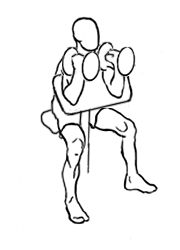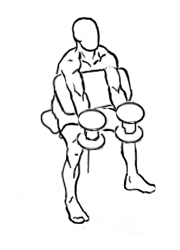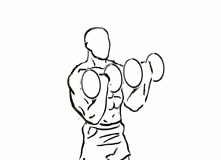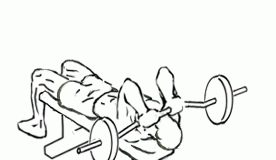Last Updated on September 30, 2014
When it comes to building stronger, more defined biceps and forearms, the Preacher Hammer Curl with Dumbbells is an excellent exercise to add to your routine. Combining the stability of the preacher bench with the unique grip of the hammer curl, this exercise focuses on maximizing bicep engagement while also working the forearms. Unlike traditional curls, the hammer grip activates different muscle fibers, adding depth to your arm training.
Whether you’re a beginner or an experienced lifter, the Preacher Hammer Curl with Dumbbells is a versatile exercise that enhances strength, muscle size, and definition in the upper arms and forearms. In this comprehensive guide, we’ll walk you through every aspect of this exercise—from the steps, key benefits, and muscle groups worked to common mistakes, variations, and tips for maximizing your results.
What is the Preacher Hammer Curl with Dumbbells?
The Preacher Hammer Curl with Dumbbells combines two powerful elements of bicep training: the preacher bench and the hammer grip. Here’s what makes each part unique:
- The Preacher Bench: The preacher bench provides stability and allows for isolation of the biceps, as your arms are fully supported on the angled pad. This fixed position reduces momentum, meaning the biceps are doing most of the work.
- The Hammer Grip: Using a hammer grip (palms facing each other) focuses on the brachialis muscle, which lies beneath the biceps brachii, and the brachioradialis muscle in the forearm. This grip provides a different angle than standard curls, activating both the upper and lower arms and enhancing the thickness and definition of the biceps.
Together, the preacher bench and hammer grip make this exercise a favorite for anyone looking to maximize arm development and target multiple areas of the arm.
Benefits of the Preacher Hammer Curl with Dumbbells
1. Enhanced Isolation of the Biceps
The preacher bench design keeps your upper arms stabilized, preventing other muscles from assisting during the movement. This isolation targets the biceps directly, which can result in better strength gains and muscle growth.
2. Increased Forearm Activation
The hammer grip activates the forearm muscles, specifically the brachioradialis, which is a common weak point in many people’s arm training. Adding the hammer grip helps improve forearm strength and thickness, making this exercise especially useful for overall arm aesthetics.
3. Reduced Risk of Cheating
Using the preacher bench helps keep the upper arms in a fixed position, eliminating the tendency to swing or use momentum. This makes it harder to cheat, as only the biceps and forearms are working, providing a safer, more controlled way to work the arms.
4. Versatile for All Fitness Levels
Whether you’re just starting or have been lifting for years, the preacher hammer curl is a great addition to your arm routine. Beginners benefit from the stability and control, while experienced lifters can add intensity by using heavier weights or different variations.
5. Builds Balanced Arm Strength
Most bicep exercises focus on the biceps brachii alone. However, the hammer grip targets the brachialis and brachioradialis, creating a more balanced arm appearance. By working these secondary muscles, you’re creating a more symmetrical look and improving the functional strength of your arms.
Muscles Worked in the Preacher Hammer Curl with Dumbbells
- Biceps Brachii: The main muscle targeted, responsible for flexing the elbow and rotating the forearm.
- Brachialis: Located underneath the biceps brachii, this muscle adds thickness and width to the upper arm.
- Brachioradialis: A forearm muscle that plays a major role in elbow flexion and wrist stability, giving the forearms a fuller look.
- Deltoids (front portion): The anterior deltoid stabilizes the shoulder, though it’s only slightly engaged in this exercise.
By engaging these muscles, the preacher hammer curl not only builds the biceps but also supports grip strength and wrist stability.
Step-by-Step Guide to Performing the Preacher Hammer Curl with Dumbbells
Step 1: Adjust the Bench
- Begin by adjusting the seat of the preacher bench so your upper arms rest comfortably on the pad. The top of the bench should align with your chest.
- Make sure you can extend your arms fully without losing contact with the pad; this setup ensures a full range of motion.
Step 2: Position Yourself
- Sit down and position your chest against the preacher bench pad.
- Place your upper arms flat on the pad, and ensure that your armpits are just over the edge of the pad. Your arms should be extended but not locked out entirely.
Step 3: Grip the Dumbbells
- Hold a dumbbell in each hand using a hammer grip (palms facing each other). Your hands should be about shoulder-width apart, giving you a comfortable and balanced grip.
Step 4: Curl the Dumbbells Upward
- Keeping your elbows and upper arms pressed against the pad, curl the dumbbells up toward your head. Focus on contracting your biceps as you lift the weights.
- Continue to curl until your forearms are nearly vertical, or until you feel a strong contraction in your biceps.
Step 5: Pause and Squeeze
- Pause at the top of the movement and squeeze your biceps for a moment. This short pause increases time under tension, enhancing the effectiveness of the exercise.
Step 6: Lower the Dumbbells
- Slowly lower the dumbbells back to the starting position, keeping your arms fully extended. Lowering the weight in a controlled manner is essential, as it prevents jerking and helps maintain stability.
Pro Tip: Perform each rep in a slow, controlled manner, focusing on form and muscle engagement over speed.
Common Mistakes to Avoid
- Lifting the Elbows Off the Pad
- Lifting the elbows or arms off the pad during the movement reduces the isolation of the biceps. Ensure that your upper arms remain pressed against the pad for maximum effectiveness.
- Using Too Much Weight
- Heavy weights might lead to swinging or jerking the dumbbells, compromising form. Start with a manageable weight to master your form, then gradually increase as your strength improves.
- Rushing the Movement
- Speeding through the exercise limits the muscle engagement and reduces the benefits of each rep. Keep your movements controlled and deliberate for the best results.
- Not Using the Full Range of Motion
- Bringing the weights only halfway up or not fully lowering them misses out on full muscle engagement. Use the complete range of motion to ensure optimal muscle activation.
- Neglecting the Eccentric Phase
- Many people focus on curling the weight up but ignore the lowering phase. Taking the time to control the weight as you lower it helps build muscle and strength, as the eccentric phase is equally important.
Variations of the Preacher Hammer Curl with Dumbbells
To keep your workouts engaging and target the biceps from different angles, try incorporating these variations:
1. Single-Arm Preacher Hammer Curl
Focusing on one arm at a time allows you to correct any imbalances between the left and right arms. You’ll also be able to concentrate better on each bicep, ensuring correct form and muscle engagement.
2. Reverse Preacher Curl with Dumbbells
Using a reverse grip (palms facing down) emphasizes the brachioradialis and forearm muscles. This variation provides additional wrist stability and forearm strength, which is beneficial for overall arm development.
3. Preacher Hammer Curl with Cable
Using a cable machine instead of dumbbells provides constant tension throughout the movement, enhancing the workout’s effectiveness. Adjust the cable height so that it mimics the preacher curl setup, and keep the hammer grip.
4. Drop Sets
After reaching muscle fatigue with a certain weight, reduce the weight and continue with more reps. Drop sets increase muscle endurance and are great for those aiming to achieve a defined look.
How to Incorporate the Preacher Hammer Curl into Your Workout
If you’re building an arm day routine, the preacher hammer curl with dumbbells makes an excellent addition. Here’s a sample workout structure to maximize your arm gains:
Sample Arm Workout with Preacher Hammer Curl
1. Warm-Up
- Light cardio (5-10 minutes) and dynamic arm stretches.
2. Standard Bicep Curl with Dumbbells
- Sets: 3 | Reps: 12-15
3. Preacher Hammer Curl with Dumbbells
- Sets: 3 | Reps: 10-12
4. Concentration Curl
- Sets: 3 | Reps: 12-15 per arm
5. Tricep Pushdown (Cable or Machine)
- Sets: 3 | Reps: 12-15
6. Hammer Curl (Standard, Standing)
- Sets: 3 | Reps: 10-12
7. Cool-Down
- Light stretching and foam rolling, focusing on the arms and shoulders.
This routine incorporates different angles and grips to provide a balanced arm workout, ensuring full development of the biceps, triceps, and forearms.
Tips for Better Results with the Preacher Hammer Curl with Dumbbells
1. Focus on Slow Reps
Slower reps increase time under tension, which can lead to better muscle growth and strength gains. Try lowering the weight for 3-4 seconds before lifting it back up.
2. Mind-Muscle Connection
Think about squeezing the bicep muscle as you lift the weight, especially during the pause at the top of the movement. This connection helps improve form and makes each rep more effective.
3. Vary Your Routine
While the preacher hammer curl is a fantastic exercise, varying your bicep exercises prevents plateaus. Try combining preacher curls with other arm exercises like chin-ups, incline curls, and barbell curls.
4. Rest Between Sets
Give your muscles time to recover between sets, aiming for 30-60 seconds of rest. Short rests might reduce your ability to maintain form, especially as weights increase.
5. Track Your Progress
Log your reps, sets, and weights to monitor progress over time. Increasing weight or reps steadily can help you avoid plateaus and continue improving.
Frequently Asked Questions
1. How heavy should I go with dumbbells on the preacher hammer curl?
- It’s best to start with a moderate weight that allows you to perform each rep with perfect form. Once you feel comfortable, you can gradually increase the weight.
2. How often should I do preacher hammer curls?
- Two to three times a week is a good frequency, with rest days in between to allow for muscle recovery and growth.
3. Can I do preacher hammer curls with barbells?
- Yes, but using dumbbells gives you more range of motion, and the hammer grip is generally easier to achieve with dumbbells.
4. Is this exercise safe for beginners?
- Absolutely! The preacher bench helps stabilize the movement, making it safe and effective for all levels. Just start with a lighter weight to master your form.
5. What if I don’t feel the muscle working during the exercise?
- If you don’t feel the burn in your biceps, try focusing more on form and possibly reducing the weight. Ensuring your arms are fully supported on the pad and avoiding momentum can also help.
The Preacher Hammer Curl with Dumbbells is an exceptional exercise for anyone looking to build defined, strong arms. The combination of the preacher bench and hammer grip allows for focused, controlled movements that isolate the biceps and forearms. By incorporating this exercise into your routine, avoiding common mistakes, and following the tips for success, you’re well on your way to stronger, more sculpted arms.
Whether you’re a beginner learning the basics or a seasoned athlete refining your arm workouts, the preacher hammer curl can be a valuable addition to your fitness plan. Give it a try, and watch your biceps and forearms transform over time!








